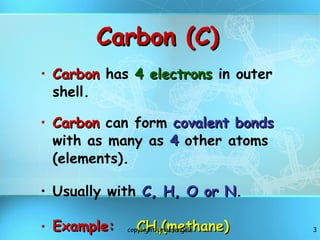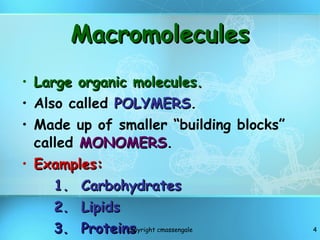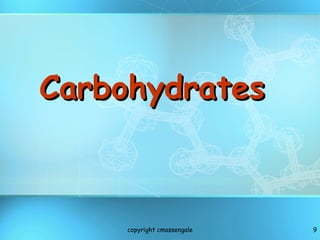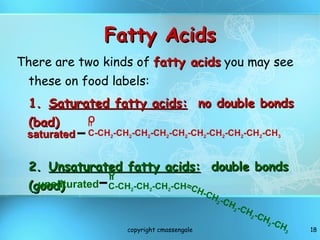Macromolecules scf 1.4.1
- 2. Organic Compounds Compounds that contain CARBON are called organic . Macromolecules are large organic molecules . copyright cmassengale
- 3. Carbon (C) Carbon has 4 electrons in outer shell. Carbon can form covalent bonds with as many as 4 other atoms (elements). Usually with C, H, O or N . Example: CH 4 (methane) copyright cmassengale
- 4. Macromolecules Large organic molecules. Also called POLYMERS . Made up of smaller “building blocks” called MONOMERS . Examples: 1. Carbohydrates 2. Lipids 3. Proteins 4. Nucleic acids (DNA and RNA) copyright cmassengale
- 5. Question: How Are Macromolecules Formed? copyright cmassengale
- 6. Answer: Dehydration Synthesis Also called “condensation reaction” Forms polymers by combining monomers by “removing water” . copyright cmassengale HO H HO HO H H H 2 O
- 7. Question: How are Macromolecules separated or digested? copyright cmassengale
- 8. Answer: Hydrolysis Separates monomers by “adding water” copyright cmassengale HO HO H H HO H H 2 O
- 10. Carbohydrates Small sugar molecules to large sugar molecules . Examples: A. monosaccharide B. disaccharide C. polysaccharide copyright cmassengale
- 11. Carbohydrates Monosaccharide: one sugar unit Examples: glucose ( C 6 H 12 O 6 ) deoxyribose ribose Fructose Galactose glucose
- 12. Carbohydrates Disaccharide: two sugar unit Examples: Sucrose (glucose+fructose) Lactose (glucose+galactose) Maltose (glucose+glucose) glucose glucose
- 13. Carbohydrates Polysaccharide: many sugar units Examples: starch (bread, potatoes) glycogen (beef muscle) cellulose (lettuce, corn) glucose glucose glucose glucose glucose glucose glucose glucose cellulose
- 15. Lipids General term for compounds which are not soluble in water . Lipids are soluble in hydrophobic solvents . Remember: “stores the most energy” Examples: 1. Fats 2. Phospholipids 3. Oils 4. Waxes 5. Steroid hormones 6. Triglycerides
- 16. Lipids Six functions of lipids: 1. Long term energy storage 2. Protection against heat loss (insulation) 3. Protection against physical shock 4. Protection against water loss 5. Chemical messengers (hormones) 6. Major component of membranes (phospholipids) copyright cmassengale
- 17. Lipids Triglycerides: c omposed of 1 glycerol and 3 fatty acids . copyright cmassengale H H-C----O H-C----O H-C----O H glycerol O C-CH 2 -CH 2 -CH 2 -CH 2 -CH 2 -CH 2 -CH 2 -CH 2 -CH 2 -CH 3 = fatty acids O C-CH 2 -CH 2 -CH 2 -CH 2 -CH 2 -CH 2 -CH 2 -CH 2 -CH 2 -CH 3 = O C-CH 2 -CH 2 -CH 2 -CH =CH-CH 2 -CH 2 -CH 2 -CH 2 -CH 3 =
- 18. Fatty Acids There are two kinds of fatty acids you may see these on food labels: 1. Saturated fatty acids: no double bonds (bad) 2. Unsaturated fatty acids: double bonds (good) copyright cmassengale O C-CH 2 -CH 2 -CH 2 -CH 2 -CH 2 -CH 2 -CH 2 -CH 2 -CH 2 -CH 3 = saturated O C-CH 2 -CH 2 -CH 2 -CH =CH-CH 2 -CH 2 -CH 2 -CH 2 -CH 3 = unsaturated
- 20. Proteins (Polypeptides) Amino acids (20 different kinds of aa) bonded together by peptide bonds ( polypeptides ). Six functions of proteins: 1. Storage: albumin (egg white) 2. Transport: hemoglobin 3. Regulatory: hormones 4. Movement: muscles 5. Structural: membranes, hair, nails 6. Enzymes: cellular reactions copyright cmassengale
- 21. Proteins (Polypeptides) Four levels of protein structure: A. Primary Structure B. Secondary Structure C. Tertiary Structure D. Quaternary Structure copyright cmassengale
- 22. Primary Structure Amino acids bonded together by peptide bonds (straight chains) copyright cmassengale aa1 aa2 aa3 aa4 aa5 aa6 Peptide Bonds Amino Acids (aa)
- 23. Secondary Structure 3-dimensional folding arrangement of a primary structure into coils and pleats held together by hydrogen bonds . Two examples: copyright cmassengale Alpha Helix Beta Pleated Sheet Hydrogen Bonds
- 24. Tertiary Structure Secondary structures bent and folded into a more complex 3-D arrangement of linked polypeptides Bonds: H-bonds, ionic, disulfide bridges (S-S) Call a “subunit”. copyright cmassengale Alpha Helix Beta Pleated Sheet
- 25. Quaternary Structure Composed of 2 or more “subunits” Globular in shape Form in Aqueous environments Example: enzymes (hemoglobin) copyright cmassengale subunits
- 27. Enzymes = Proteins End in – ase Identifies a reacting substance sucrase – reacts sucrose lipase - reacts lipid Describes function of enzyme oxidase – catalyzes oxidation hydrolase – catalyzes hydrolysis Common names of digestion enzymes still use – in pepsin, trypsin copyright cmassengale
- 28. Enzymes = Proteins = Catalyst Catalyst are enzymes that speed up a reaction. Lock and key model An enzyme binds a substrate in a region called the active site Only certain substrates can fit the active site Enzymes are VERY SPECIFIC copyright cmassengale
- 29. Synthesis Reaction copyright cmassengale Active site
- 30. Lowers the ACTIVATION energy input required for a chemical reaction to happen remains unchanged at the end of the reaction Enzymes= Catalysts copyright cmassengale Activation Energy Activation Energy
- 31. Nucleic Acids copyright cmassengale
- 32. Nucleic acids Two types: a. Deoxyribonucleic acid (DNA- double helix) b. Ribonucleic acid (RNA-single strand) Nucleic acids are composed of long chains of nucleotides linked by dehydration synthesis . copyright cmassengale
- 33. Nucleic acids Nucleotides include: phosphate group pentose sugar (5-carbon) nitrogenous bases: adenine (A) thymine (T) DNA only uracil (U) RNA only cytosine (C) guanine (G) copyright cmassengale
- 34. Nucleotide copyright cmassengale O O=P-O O Phosphate Group N Nitrogenous base (A, G, C, or T) CH2 O C 1 C 4 C 3 C 2 5 Sugar (deoxyribose)
- 35. DNA - double helix copyright cmassengale P P P O O O 1 2 3 4 5 5 3 3 5 P P P O O O 1 2 3 4 5 5 3 5 3 G C T A
- 36. RNA - double helix copyright cmassengale P P P O O O 1 2 3 4 5 5 3 3 5 P P P O O O 1 2 3 4 5 5 3 5 3 G C U A



































